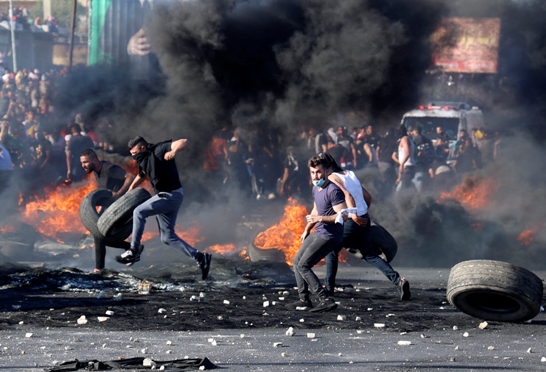Death toll climbs in Israel-Gaza conflict amid UN deadlock

By Sakher Abou El Oun and Ben Simon
GAZA CITY /JERUSALEM – Heavy air strikes and rocket fire in the Israel-Gaza conflict claimed more lives on both sides Tuesday (18) as tensions flared in Palestinian “day of anger” protests in Jerusalem and the West Bank.
Calls for a ceasefire intensified, but Prime Minister Benjamin Netanyahu vowed Israel would continue its onslaught on the coastal enclave “as long as necessary,” before a UN Security Council meeting broke up after less than an hour without issuing a statement.
Israeli forces and protesters meanwhile clashed at multiple flashpoints across the occupied West Bank and in east Jerusalem, hospitalizing scores, as Palestinians rallied in solidarity with their besieged Gazan counterparts. Dozens were treated for wounds caused by live bullets, medics said.
Israel’s near-relentless bombing campaign has killed 217 Palestinians, including 63 children, and wounded more than 1,400 people in just over a week in the Hamas-run enclave, according to Gaza’s health ministry.
The death toll on the Israeli side rose to 12 when a volley of rockets Hamas fired at the southern Eshkol region killed two Thai nationals working in a factory and wounded several others, police said.
Israeli strikes that again sent fireballs, debris and black smoke into the sky have left two million Palestinians in Gaza desperate for reprieve.
“They destroyed our house but I don’t know why they targeted us,” said Nazmi al-Dahdouh, 70, of Gaza City who remained shocked by what he called “a terrifying, violent night”.
The humanitarian crisis deepened in the impoverished strip, from where Hamas has launched nearly 3,500 rockets at Israel since May 10, often forcing people living near Gaza into bomb shelters around the clock.
But a convoy of international aid trucks that started rolling into Gaza through a border crossing from Israel, Kerem Shalom, was halted when Israel quickly shuttered it again, citing a mortar attack on the area.
Tuesday’s UN Security Council session, the fourth since the conflict escalated, was called after the United States, a key Israel ally, the previous day once again blocked adoption of a joint statement calling for a halt to the violence.
But the latest session again closed without consensus. “We do not judge that a public pronouncement right now will help de-escalate,” US envoy Linda Thomas-Greenfield said during Tuesday’s closed-door meeting, according to a diplomat.
France and Egypt are pushing for a ceasefire deal, while Qatar and Egypt are working another channel, via the UN.
EU foreign policy chief Josep Borrell on Tuesday strongly backed the manifold calls for a ceasefire, while urging Israel’s military to act in a “proportionate” manner.
The conflict risks precipitating a humanitarian disaster, with the UN saying 58,000 Palestinians have been displaced and 2,500 have lost their homes.
Fighter jets have hit Hamas’s underground tunnels, which Israel has previously acknowledged run in part through civilian areas.
A strike Monday (17) knocked out Gaza’s only COVID-19 testing laboratory, the health ministry said, and the Qatari Red Crescent said a strike damaged one of its offices.
Hospitals in the territory, which has been under Israeli blockade for almost 15 years, have been overwhelmed by patients and there are frequent power blackouts.
Speaking at an air force base in Israel’s south, Netanyahu said Hamas and Islamic Jihad had “received blows they didn’t expect.”
“We’ve taken them many years back,” the premier said. “We’ll continue as long as necessary to bring… quiet back to the citizens of Israel.”
Palestinians across the West Bank and in Israeli-annexed east Jerusalem mobilised Tuesday for protests and a general strike that shuttered non-essential businesses, in support of those under bombardment in Gaza.
Palestinian president Mahmud Abbas’s Fatah movement had called for a ‘day of anger’, a call echoed in Arab and ethnically mixed towns inside Israel.
“We are here to raise our voice and stand with the people in Gaza who are being bombed,” Ramallah protester Aya Dabour told AFP.
In Jerusalem, Ala Judeh, 24, said he was on strike from his job as a gas station attendant in a Jewish neighbourhood in west Jerusalem.
Thanks to this strike, “we are starting to feel we are not just their slaves,” said the Palestinian resident of the occupied east of the city.
Israel’s army said troops came under fire north of Ramallah. It said two soldiers suffered leg injuries and were taken to hospital.
The Palestinian health ministry said four Palestinians were shot dead in the West Bank, bringing to 24 the total number of Palestinians killed there since May 10.
The Israeli army said one had attempted to attack soldiers in Hebron.
The Palestinian Red Crescent said its teams had treated more than 150 people in Jerusalem and the occupied West Bank, including 35 with live bullet wounds and more than 80 suffering from tear gas inhalation.
Earlier in the day, an assailant who attempted to attack soldiers in the West Bank city of Hebron was shot dead.
Tensions again flared in east Jerusalem’s flashpoint Sheikh Jarrah neighbourhood, where Palestinian protesters faced off against police, who used stun grenades and “skunk water” cannon to disperse protesters.
The Israel-Gaza conflict was sparked after clashes broke out at east Jerusalem’s flashpoint Al-Aqsa mosque compound — one of Islam’s holiest sites.
This followed a crackdown against protests over planned evictions of Palestinians in Sheikh Jarrah.
-Agence France-Presse

